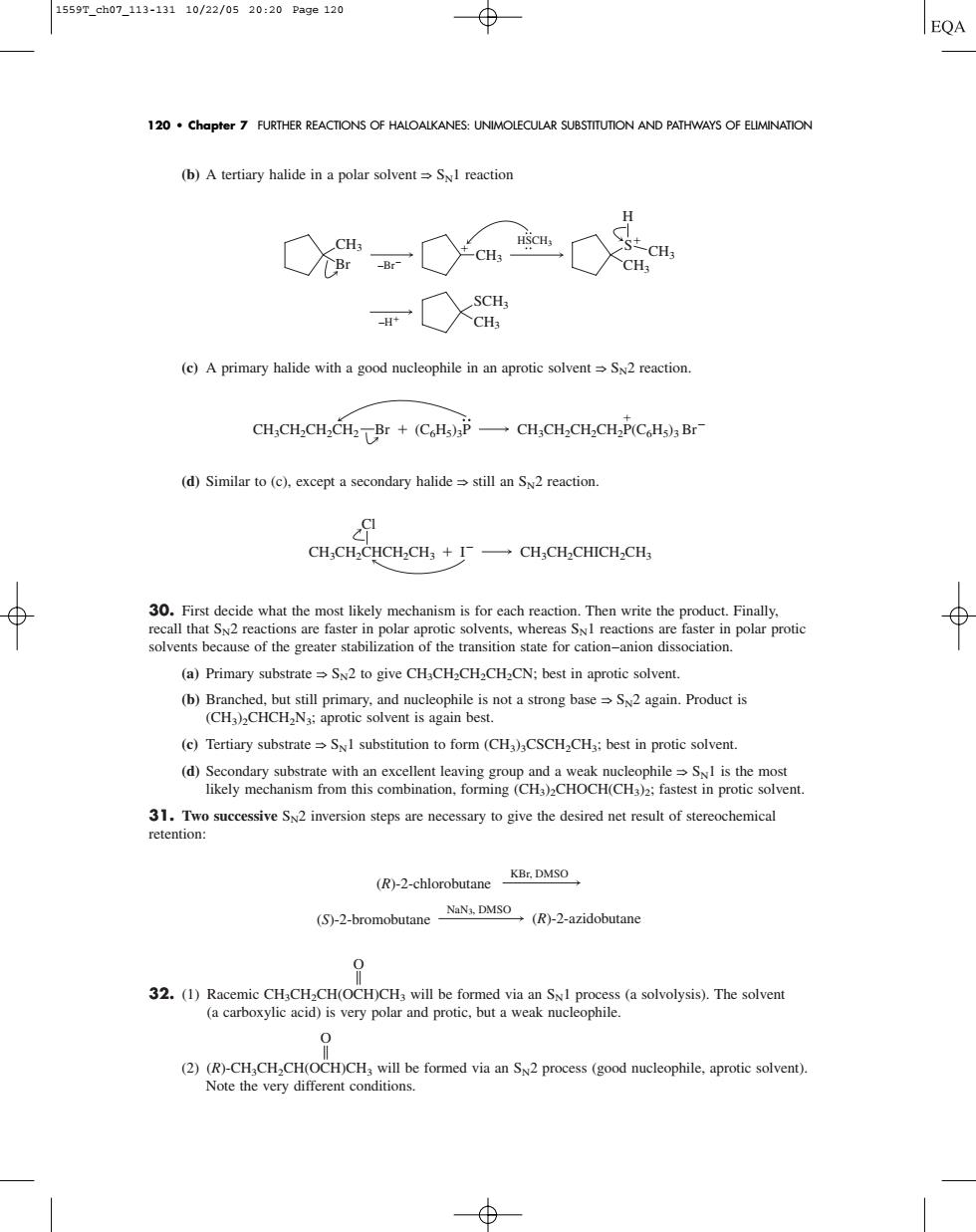正在加载图片...

15597.ch07.113-13110/22/0520:20Page120 120 chapter 7 FURTHER REACTONS OF HALOALKANES:UNIMOLECULAR SUBSTTTUTION AND PATHWAYS OF ELIMINATION (b)A tertiary halide in a polar solventS reaction r○X (c)A primary halide with a good nucleophile in an aprotic solvent2 reaction CH;CH.CH2CH2TBr+(C.Hs)p-CH.CHCH.CHaP(CoHa)3Br (d)Similar to (e).except a secondary halidestill an S2 reaction. CH,CH,CHCH,CH3+厂→CH,CH,CHICH,CH solvents because of the greater stabilization of the transition state for cation-anion dissociation. (a)Primary substrateSx2 to give,CN:best in aprotic solvent. 82e血ot (e)Tertiary substrateS substitution to form(CH)CSCH,CH:best in protic solvent. 31.Two successive S2 inversion steps are necessary to give the desired net result of stereochemical retention: (R)-2-chlorobutane (5--bromobutane-2-azdobutane 0 32.(1)Racemie CH,CH2CH(OCH)CH3 will be formed via an SI process (a solvolysis).The solvent (a carboxylic acid)is very polar and protic.but a weak nucleophile. (2)(R)-CH,CH,CH(OCH)CH,will be formed via an S.2 process (good nucleophile.aprotic solvent) Note the very different conditions.(b) A tertiary halide in a polar solvent F SN1 reaction (c) A primary halide with a good nucleophile in an aprotic solvent F SN2 reaction. (d) Similar to (c), except a secondary halide F still an SN2 reaction. 30. First decide what the most likely mechanism is for each reaction. Then write the product. Finally, recall that SN2 reactions are faster in polar aprotic solvents, whereas SN1 reactions are faster in polar protic solvents because of the greater stabilization of the transition state for cation–anion dissociation. (a) Primary substrate F SN2 to give CH3CH2CH2CH2CN; best in aprotic solvent. (b) Branched, but still primary, and nucleophile is not a strong base F SN2 again. Product is (CH3)2CHCH2N3; aprotic solvent is again best. (c) Tertiary substrate F SN1 substitution to form (CH3)3CSCH2CH3; best in protic solvent. (d) Secondary substrate with an excellent leaving group and a weak nucleophile F SN1 is the most likely mechanism from this combination, forming (CH3)2CHOCH(CH3)2; fastest in protic solvent. 31. Two successive SN2 inversion steps are necessary to give the desired net result of stereochemical retention: O B 32. (1) Racemic CH3CH2CH(OCH)CH3 will be formed via an SN1 process (a solvolysis). The solvent (a carboxylic acid) is very polar and protic, but a weak nucleophile. O B (2) (R)-CH3CH2CH(OCH)CH3 will be formed via an SN2 process (good nucleophile, aprotic solvent). Note the very different conditions. (R)-2-chlorobutane (R)-2-azidobutane KBr, DMSO (S)-2-bromobutane NaN3, DMSO CH3CH2CHCH2CH3 CH3CH2CHICH2CH3 Cl I CH3CH2CH2CH2P(C6H5)3 Br CH3CH2CH2CH2 Br (C6H5)3P S Br CH3 CH3 SCH3 CH3 CH3 CH3 H –Br –H HSCH3 120 • Chapter 7 FURTHER REACTIONS OF HALOALKANES: UNIMOLECULAR SUBSTITUTION AND PATHWAYS OF ELIMINATION 1559T_ch07_113-131 10/22/05 20:20 Page 120������